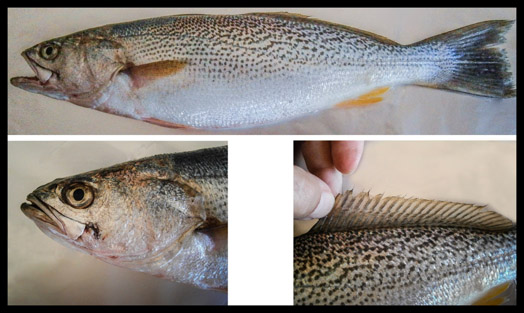 A species of croaker native to the east coast of the United States was first found in the estuary of the River Guadiana by a local fisherman and identified by two researchers from the Center for Marine Sciences in the Algarve.
A species of croaker native to the east coast of the United States was first found in the estuary of the River Guadiana by a local fisherman and identified by two researchers from the Center for Marine Sciences in the Algarve.
According to the research center associated with the University of Algarve, this is an invasive species, which was recently introduced into the Iberian Peninsula.
The discovery of a specimen of the so-called royal croaker (Cynoscion regalis) «surprised both the scientific community and the local fishermen, who were intrigued by the discovery of a species originating from such a distant place», namely the fisherman José Estica, responsible for capturing the specimen, and the researchers who identified it, according to the CCMar.
“Interestingly, other specimens of the same species had been captured in November 2015 in the Gulf of Cádiz and, last week, in Galicia. According to the researchers, the few records of the presence of this species in the Iberian Peninsula suggest that it may have been introduced recently (1-2 years), despite being found in such remote places. Thus, one of the questions to be answered is the time it took from its introduction until it was detected for the first time”, stresses the centre.
The introduction of non-native species “is quite common, even in the Guadiana estuary”. «However, in this specific case, researchers are still studying the way of introduction, since there is no record of exploitation of real croaker in European aquaculture nurseries and therefore it is not possible for some individuals to escape to rivers and the ocean,” says the Algarve research centre.
«The hypothesis of the species having been introduced only in a single place through its transport in the ballast waters of ships seems implausible, as there is already a record of the capture of the royal croaker in Galicia. Even so, the introduction by ballast water, in multiple locations, is undoubtedly a possibility to be explored», adds the CCMar.
Pedro Morais, CCMAR researcher, recalls that, in the Guadiana River, there is another species of this fish, the real croaker (argyrosomus regius), and that another of the big questions that arise is whether this species will be able to coexist with the non-native (royal croaker Cynoscion regalis), since both use the estuaries as maternity and feeding places.
Although these species belong to the same family, these two croakers have very different characteristics. The real croaker can reach up to two meters in length and almost a hundred kilos in weight, while the real croaker can reach, in adulthood, no more than one meter in length and nine kilos in weight, according to the researcher and author of a book. recently published on migratory fish.
Alexandra Teodósio, leader of a CCMAR research group and professor at the University of Algarve, stresses the importance of contact with fishermen and society in general in the detection of non-native aquatic species and in the identification of other ecological problems, «because research it must respond to the problems of the local communities».
“For example, with the use of new communication technologies, a question or photograph that is posted on CCMAR's Facebook is enough for us to establish a first contact,” he said.


















Comments